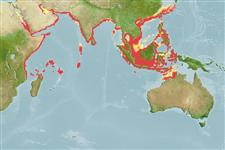Common names from other countries
Environment: milieu / climate zone / depth range / distribution range
Écologie
Démersal; profondeur 3 - 170 m (Ref. 275). Tropical; 30°N - 15°S, 32°E - 131°E (Ref. 275)
Indo-West Pacific: Indian Ocean, Red Sea and Arabian Sea, eastwards from Mozambique to South China Sea and the Philippine Sea, northward to Taiwan.
Length at first maturity / Taille / Poids / Âge
Maturity: Lm 10.0, range 9 - 12.9 cm Max length : 40.0 cm ML mâle / non sexé; (Ref. 116232); 23.5 cm ML (female); poids max. publié: 1.5 kg (Ref. 275); âge max. reporté: 3.00 années (Ref. 275)
Maximum size for female, 23.5 cm, mantle length from Ref. 116229. Minimum depth from Ref. 104457. Neritic, on shallow waters (Refs. 275, 128042). Feeds on fishes, crustaceans and squids (Refs. 275, 104236). Cannibalism is common (Ref. 275).
Members of the class Cephalopoda are gonochoric. Male and female adults usually die shortly after spawning and brooding, respectively. Mating behavior: Males perform various displays to attract potential females for copulation. During copulation, male grasp the female and inserts the hectocotylus into the female's mantle cavity where fertilization usually occurs. Life cycle: Embryos hatch into planktonic stage and live for some time before they grow larger and take up a benthic existence as adults.
Roper, C.F.E., M.J. Sweeney and C.E. Nauen. 1984. (Ref. 275)
Statut dans la liste rouge de l'IUCN (Ref. 130435)
statut CITES (Ref. 108899)
Not Evaluated
Not Evaluated
Utilisations par l'homme
Pêcheries: commercial
| FishSource |
Outils
Sources Internet
Estimates based on models
Preferred temperature
(Ref.
115969): 22.9 - 28.6, mean 27.4 (based on 961 cells).
Résilience
Haut, temps minimum de doublement de population inférieur à 15 mois (K=0.3-2.25; tm=1; tmax=3).
Vulnérabilité
Low vulnerability (14 of 100).
